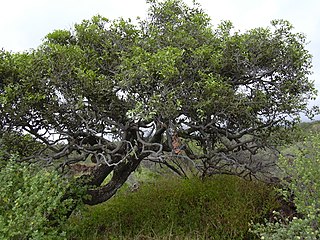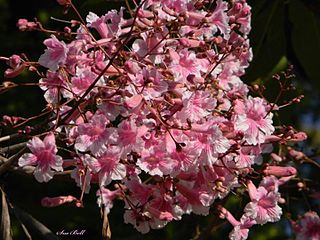
Sumac, also spelled sumach, is any of about 35 species of flowering plants in the genus Rhus and related genera in the cashew family (Anacardiaceae). Sumacs grow in subtropical and temperate regions throughout the world, including East Asia, Africa, and North America. Sumac is used as a spice, as a dye, and in medicine.

The Ebenaceae are a family of flowering plants belonging to order Ericales. The family includes ebony and persimmon among about 768 species of trees and shrubs. It is distributed across the tropical and warmer temperate regions of the world. It is most diverse in the rainforests of Malesia, India, tropical Africa and tropical America.

Curtisia dentata is a flowering tree from Southern Africa. It is the sole species in genus Curtisia, which was originally classed as a type of "dogwood" (Cornaceae), but is now placed in its own unique family Curtisiaceae.

Cornus is a genus of about 30–60 species of woody plants in the family Cornaceae, commonly known as dogwoods, which can generally be distinguished by their blossoms, berries, and distinctive bark. Most are deciduous trees or shrubs, but a few species are nearly herbaceous perennial subshrubs, and some species are evergreen. Several species have small heads of inconspicuous flowers surrounded by an involucre of large, typically white petal-like bracts, while others have more open clusters of petal-bearing flowers. The various species of dogwood are native throughout much of temperate and boreal Eurasia and North America, with China, Japan, and the southeastern United States being particularly rich in native species.

Manzanita is a common name for many species of the genus Arctostaphylos. They are evergreen shrubs or small trees present in the chaparral biome of western North America, where they occur from Southern British Columbia and Washington to Oregon, California, Utah, Arizona, New Mexico, and Texas in the United States, and throughout Mexico. Manzanitas can live in places with poor soil and little water. They are characterized by smooth orange or red bark and stiff, twisting branches. There are 105 species and subspecies of manzanita, 95 of which are found in the Mediterranean climate and colder mountainous regions of California, ranging from ground-hugging coastal and mountain species to small trees up to 20 feet (6m) tall. Manzanitas bloom from winter to early spring and carry berries in spring and summer. The berries and flowers of most species are edible.

Alnus glutinosa, the common alder, black alder, European alder, European black alder, or just alder, is a species of tree in the family Betulaceae, native to most of Europe, southwest Asia and northern Africa. It thrives in wet locations where its association with the bacterium Frankia alni enables it to grow in poor quality soils. It is a medium-sized, short-lived tree growing to a height of up to 30 metres (98 feet). It has short-stalked rounded leaves and separate male and female flowers in the form of catkins. The small, rounded fruits are cone-like and the seeds are dispersed by wind and water.

Vachellia nilotica, more commonly known as Acacia nilotica, and by the vernacular names of gum arabic tree, babul, thorn mimosa, Egyptian acacia or thorny acacia, is a flowering tree in the family Fabaceae. It is native to Africa, the Middle East and the Indian subcontinent. It is also considered a 'weed of national significance' and an invasive species of concern in Australia, as well as a noxious weed by the federal government of the United States.

Vachellia sieberiana, until recently known as Acacia sieberiana and commonly known as the paperbark thorn or paperbark acacia, is a tree native to southern Africa and introduced into Pakistan. It is used in many areas for various purposes. The tree varies from 3 to 25 m in height, with a trunk diameter of 0.6 to 1.8 m. It is not listed as being a threatened species.

Commiphora myrrha, called myrrh, African myrrh, herabol myrrh, Somali myrrhor, common myrrh, is a tree in the Burseraceae family. It is one of the primary trees used in the production of myrrh, a resin made from dried tree sap. The tree is native to the Arabian peninsula and to Africa. It is called 'mur' (المر) in Arabic, meaning bitter. It famously comes from Mecca, so it is called 'Mur Makki'.

Ziziphus mucronata, known as the buffalo thorn, is a species of tree in the family Rhamnaceae, native to southern Africa. It is deciduous and may grow up to 17 metres tall. It can survive in a variety of soil types, occurring in many habitats, mostly open woodlands, often on soils deposited by rivers, and grows frequently on termite mounds. Its Zulu name “umLahlankosi” alludes to its use as a grave marker for tribal chiefs, while the Afrikaans name “Blinkblaar-wag-'n-bietjie” alludes to the shiny light green leaves and the hooked thorns.

Annona senegalensis, commonly known as African custard-apple, wild custard apple, wild soursop, abo ibobo, sunkungo, and dorgot is a species of flowering plant in the custard apple family, Annonaceae. The specific epithet, senegalensis, translates to mean "of Senegal", the country where the type specimen was collected.

Vachellia reficiens, commonly known as red-bark acacia, red thorn, false umbrella tree, or false umbrella thorn, is a deciduous tree or shrub of the pea family (Fabaceae) native to southern Africa, often growing in an upside-down cone shape and with a relatively flat crown.
Diospyros abyssinica is a tree species in the family Ebenaceae which is native to Sub-Saharan Africa.

Diospyros dichrophylla (Gand.) De Winter is a Southern African tree belonging to the ebony family of Ebenaceae and closely related to the Persimmon.

Maerua cafra (DC.) Pax is a small Southern African tree belonging to Capparaceae, the caper family, occurring eastwards along the coast from Knysna, then further inland and northwards through KwaZulu-Natal and Eswatini to the Transvaal, southern Mozambique and southern Zimbabwe. The genus Maerua comprises about 60 species found in Africa and Asia.

Maerua angolensis is a 10m tall, occasionally deciduous tree of the Capparaceae or caper family, often growing on termitaria and in thickets fringing seasonal watercourses, up to 1800m. Though never common, it is widespread in tropical Africa and arid regions, being absent from high-rainfall regions.

Jamesbrittenia ramosissima is a Southern African shrub in the family Scrophulariaceae occurring in the Northern Cape and southern Namibia, westward along the Gariep River from the vicinity of Augrabies Falls. It is one of some 90 species in the genus Jamesbrittenia, ranging through Africa, with 74 species occurring in Southern Africa, and 1 in India. The genus is named for James Britten (1846-1924), medical student turned botanist, and acting Keeper of Botany at the British Museum when Kuntze named it.

Klainedoxa gabonensis is a large tropical African tree of the family Irvingiaceae growing to 40m in height. Its straight trunk is buttressed and up to 25m long, while its spreading evergreen crown makes it one of the largest trees of the rainforest. It is found from Senegal to Sudan, Cameroons, Ivory Coast, Democratic Republic of the Congo, Uganda and Tanzania, growing as far south as Angola and Zambia.

Stereospermum kunthianum is an African deciduous shrub or small tree occurring in the Democratic Republic of Congo, Djibouti, Eritrea, Ethiopia, Kenya, Malawi, Senegal, Somalia, Sudan, Tanzania and Uganda. It is widespread across Africa to the Red Sea, and reaches as far south as Angola, Mozambique, Zambia and Zimbabwe. There are some 30 species with a Central African and Asian distribution.

Clerodendrum umbellatum is a scandent African shrub of the family Lamiaceae, but previously placed in Verbenaceae. It is found in Tropical Africa, Central America and Tropical Asia, its distribution being to some extent anthropogenic, and is often planted for its showy flowers. The genus Clerodendrum is large with more than 300 species currently accepted.




















